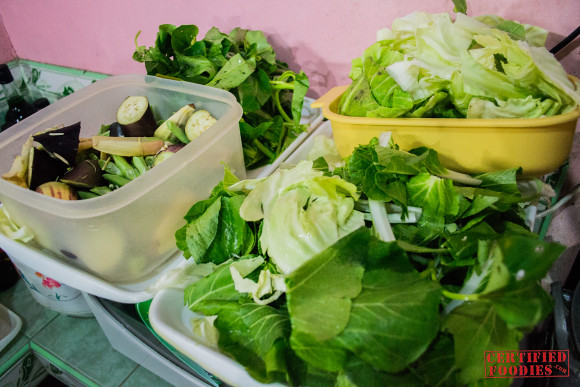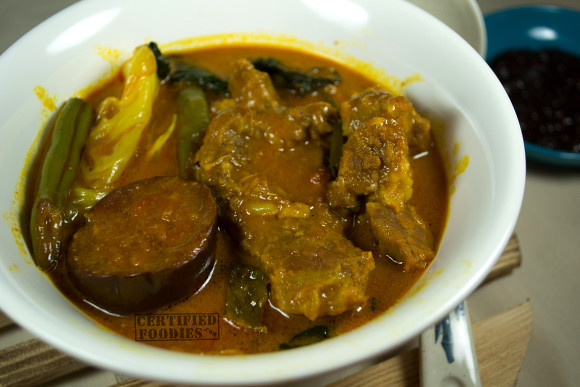If there’s one dish our nanay prepares that I would want to eat for my last meal, it would definitely be her delicious Beef Kare-kare. Looking back to my childhood days, I realize that my fondness for this dish can be traced back to the days when our nanay would prepare kare-kare as one of her sweet ways in rewarding us for doing well, may it be in school or just for simply behaving at home.
Since I started working almost a decade ago, we’ve had kare-kare more often because whenever I’m craving for it, all we need to do is provide for the ingredients and our nanay will lovingly cook it for us. She’s even made her own seafood kare-kare (after our lunch at Emohruo in Pagudpud) which I also love (see the seafood option below this article).
This is actually one reason I don’t order kare-kare at restaurants because I have high standards when it comes to the flavors of this dish. It’s certainly one of the many things I missed when I lived for a year in Cebu that I begged her for the recipe and had to have someone cook it for me exactly the way nanay instructed. It was close to how she prepares it, but nothing beats the original ’cause it’s made with pure love. 🙂
Many can attest to the tastiness of our nanay’s kare-kare. And after the long delay of sharing the recipe, we finally had the time to prepare the dish for this blog. We hope you enjoy it and please let us know how it went when you tried it. If you tweaked a couple of things, we’d love to hear about that too. 🙂
Creamy Beef Kare-kare Recipe
Kare-kare is a Philippine beef stew, usually made with oxtail or tripe, vegetables and ground peanuts. But, this recipe was made with regular beef cuts.
SERVINGS:
- Good for 8-10 people, but it’ll really depend on their appetites. The 4 of us can finish this off for lunch and dinner. 😀

INGREDIENTS:
- 3 kg beef, sliced to preferred equal parts
Mostly sirloin, but you can use 1 kg each of oxtail, tripe and sirloin.
You can even use pork if you want. The sauce is just so good, even chicken will taste delicious with it. 😀 - 1 kg cabbage (repolyo)
- 1 bundle of kangkong (water spinach), sliced
- 1 bundle of Baguio beans (bitsuelas), sliced
- 1 bundle of Pechay (bok choy), sliced
- 3-4 eggplants (depending on size), cut into 2-inch thick slices (see photo)
- 1 banana bud (puso ng saging), sliced
- 1 onion, sliced
- 1 medium clove of garlic, minced
- 1/2 cup oil
- 1/2 cup annatto seeds (atsuete)
- 1/2 to 3/4 cup glutinous/sticky rice or rice flour, toasted
– You can adjust amount depending on the thickness of the sauce that you want - 3-4 cups peanut butter (OR ground peanuts)
You can adjust this based on your preferred nuttiness. Our nanay uses regular homemade peanut butter spread that she buys from the market. If you want to use unsweetened, go right ahead. But, if you’re serving this for kids, we strongly recommend you use regular peanut butter. - Optional: Grated coconut (niyog)
– Our nanay added this to make it creamier. You’ll just need the coconut milk. See instructions below. - Salt to taste
- Bagoong (shrimp paste) for serving
PREP THE INGREDIENTS:

Most of the ingredients are easy to prepare, so we’re just giving you steps for these two:
a. 1/2 cup annatto seeds (atsuete) – This is used to add the orange-brown color of the kare-kare.

This will be used twice in this recipe. Add 1 cup of warm water and mix. Use a strainer when adding the  atsuete oil to the pan.
b. Grated coconut (niyog)
Add lukewarm water and squeeze the oil off the coconut meat (pictured below). Do this 2-3 times. Strain the coconut milk. You’ll need 1 cup.

Tip: Coconut cream is what you’ll get from the first extract without the water. Coconut milk is from the second to third extract when you squeeze it after adding lukewarm water.

PROCEDURE:
TIP: Before you start, this is best done on two (2) stoves, so you got your beef and stock cooking on one stove, and the vegetables are cooking on another. 🙂
1. In a big pot, boil the beef in water (and/or oxtail, tripe) for 2-4 hours, checking from time-to-time for the tenderness of the beef. Once done, remove the meat and set aside (preferably in a warm area).

Before you move on to step 2, make sure you’re done with this step. Keep the stock simmering in low heat. You’ll only need about 10-12 cups.
Tip: If you’re using tripe, make sure you strain the stock before you continue to use it for this recipe.
2. In a big pan (or another big pot), saute onions and garlic until slightly brown.

3. Add most of the atsuete / annatto oil to the sauteed onions and garlic. Nanay said that she does this so you won’t taste the atsuete.
 Photo on the right is for step 5.
Photo on the right is for step 5.
4. Add the eggplant, banana bud and green beans. Cook for about 5 minutes.

5. Mix in the remaining atsuete / annatto oil with the vegetables (see photo from step 3).
6. For the stock, mix in the peanut butter and toasted rice. Let it boil for a few minutes, stirring and tasting from time to time to see if you’d want to add more peanut butter or rice to thicken the kare-kare sauce.
7. Back to the pan, add the kangkong, cabbage and Pechay. Cover the pan and let cook for about 1-2 minutes.



8. Add the stock mixture (with the rice and peanut butter) gradually into the vegetables, mixing everything well. Let it cook for about a minute.
9. Add the coconut milk and mix. Let it boil for another minute or two. Our nanay uses coconut milk to make her kare-kare creamier and more flavorful, with a touch of sweetness.

10. Add salt and pepper to taste. Mix well and then let it simmer for about 2-4 minutes.
11. Serve nice and hot with bagoong and lots of rice! Sabaw pa lang nito, ulam na! 🙂

We hope you’ll love this recipe. If you have any questions or your own tweaks, again, let us know through the comments section. Enjoy! 🙂
Seafood Kare-Kare Recipe
Someone asked about our mom’s Seafood Kare-kare, so we decided to add this here:
INGREDIENTS:
- Same vegetables, annatto oil, peanut butter, etc. The only difference is there’ll be no other meat, but the seafoods.
- 1 kg shrimps
- 1 kg squid
- 1 kg fish – preferably Cream Dory, and have it sliced into fillets.
- Stock from fish (or shrimp) broth cubes
– Use 2 cubes for 10-12 cups of water. - Water
- Salt  and pepper
- Oil for frying
PROCEDURE:
1. Cook the shrimps and squid in salted water SEPARATELY. Don’t cook them in one pot. For every 10 cups of water, use 1/2 cup of salt. Set aside.
2. Fry the fish fillet until they’re golden brown. Set aside.
3. Prepare the Seafood Kare-kare the same way as the beef version, but instead, use the fish (or shrimp) broth. If you like, you can add broth from the water where you cooked the shrimp. Make sure you strain it though.
Add the stock gradually into your vegetables, mixing and tasting ’til you get the flavors you prefer while you also add salt and pepper to taste.
4. Adding the coconut milk is optional, but if you want to try it, go ahead. 🙂
That’s it! We hope you enjoy this Seafood Kare-kare recipe too!


Oh my gosh. I should definitely try making this. Question though, i haven’t been eating beef and pork for three years now and I want to know what you tweaks should i do if I use seafood instead? Thanks guys, you’re the best! 😀
@facebook-1286119936:disqus With the seafood kare-kare, I think our nanay used the stock where she cooked the shrimps, squid and fish fillet. I’ll check with her and get back to you – or we might share that recipe here too. 🙂
Wow, you haven’t eaten beef or pork for 3 years?! I don’t think I’ll last a week! Hehehe ^_^
That was so sweet of you! 🙂 Thank you for adding it up. Will definitely try to make this during the holidays and your creamy pesto pasta looks promising too 🙂
You’re welcome. 🙂 Let us know if you’ve already made this or the pesto pasta. 🙂
@facebook-1286119936:disqus – We just added the seafood option for this recipe. Let us know if you have any other question. 🙂
I just wanna ask if the recipe really calls for cabbage (repolyo) instead of pechay?
You can actually use all pechay or mix in some cabbage in there. It’s all up to you. We prefer the repolyo kasi.
is it possible to omit the annato seeds? i can’t seem to find one in my workplace
Hi, Meech. Yes, it’s okay to not include the atsuete/annatto seeds. It’s used as a natural ingredient to add color to the dish, the flavor won’t be affected. 🙂
I understand the procedure but can you make it with video? May GodBless you!